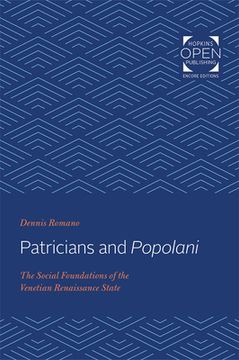Share
Patricians and Popolani: The Social Foundations of the Venetian Renaissance State
Dennis Romano
(Author)
·
Johns Hopkins University Press
· Paperback
Patricians and Popolani: The Social Foundations of the Venetian Renaissance State - Romano, Dennis
£ 35.10
£ 39.00
You save: £ 3.90
Choose the list to add your product or create one New List
✓ Product added successfully to the Wishlist.
Go to My WishlistsIt will be shipped from our warehouse between
Tuesday, August 06 and
Wednesday, August 07.
You will receive it anywhere in United Kingdom between 1 and 3 business days after shipment.
Synopsis "Patricians and Popolani: The Social Foundations of the Venetian Renaissance State"
Originally published in 1987. Since Machiavelli, historians and political theorists have sought the sources of the stability that earned for Venice the appellation La Serenissima, the Most Serene Republic. In Patricians and Popolani, Dennis Romano looks to the private lives of early Renaissance Venetians for an explanation.Fourteenth-century Venice escaped the tumultuous upheavals of the other Italian city-republics, Romano contends, because the patricians and common people of the city did not divide sharply along class or factional lines in their personal associations. Rather, Venetians of the era moved in a variety of intersecting social networks that were shaped and influenced by an overriding sense of civic community. Drawing on the private archives of Venice--notarial registers, collections of testaments, and records of estates maintained by the procurators of San Marco--Romano analyzes the primary social bonds in the lives of the city's inhabitants.In separate chapters, Patricians and Popolani examines the forms of association in everyday Venetian life: marriage and family structure; artisan workshops and relations among tradesmen; the role of the parish clergy and the "sacred networks" that formed around convents, hospitals, and confraternities; and neighborhood and patron-client ties. By the beginning of the fifteenth century, Romano argues, all these networks of association had been transformed as a new hierarchical spirit took hold and overwhelmed the older, more freewheeling tendencies of Venetian society. The old sense of community yielded to a new and equally compelling sense of place, and La Serenissima remained stable throughout the later Renaissance.
- 0% (0)
- 0% (0)
- 0% (0)
- 0% (0)
- 0% (0)
All books in our catalog are Original.
The book is written in English.
The binding of this edition is Paperback.
✓ Producto agregado correctamente al carro, Ir a Pagar.

